Musicarta Twelve-bar Piano Styles
The Moving Pair Riff
The Moving Pair Riff series of lessons builds quickly to this performance.
The Moving Pair riff notes
The basics of the Moving Pair 12-bar riff are:
- A root note, which stays the same (the green note below), and
- A moving pair of notes (the red notes).
Look at this illustration. It shows the piano keys the riff uses on chord G.
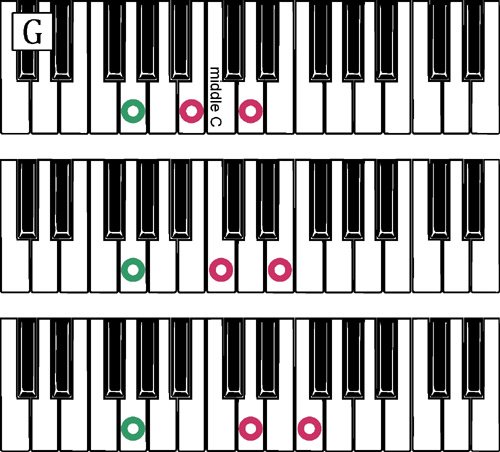
The left hand (green) plays G (the root – the note that stays the same). The right hand (red) plays the moving pair of notes. The ‘moving pair’ moves sideways one key at a time, up then down.
Find the three notes, using two hands – one in the left (green – the root or name-note of the chord) and two in the right (red – the moving pair). Use any convenient fingering for now – even the same right hand fingers for all the moving pairs (2 and 3 or 2 and 4 are shown below). Classical pianists can use traditional thirds fingering.
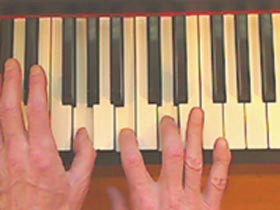 |
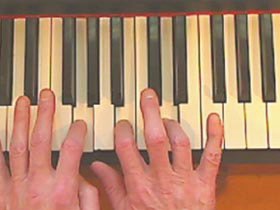 |
Playing the pattern in rhythm
Try to play just the G-position pattern using the keyboard diagrams and the performance files.
(You can slow the performance down in most media players – and in MidiPiano – to make playing along easier.)
The written-out music looks like this:

Be careful not to let the appearance of written music set your progress back! The music just represents the performance (the sound), and it’s the sound you want to reproduce.
The pattern in C
Now find the notes and play the same pattern built on root C, using these keys:
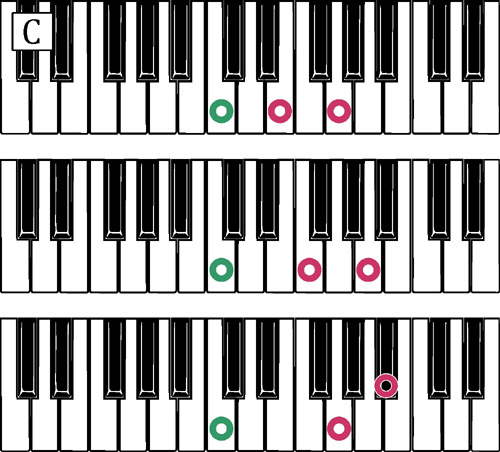
The written-out music for the pattern in C looks like this:

Resist the temptation to play from the music – it’s only there ‘for the record’ and to give you an idea of ‘shape’. You don’t play twelve-bars from music! Rather use the keyboard diagrams to find the notes and your ear to tell you how to play them.
The pattern in D
Find the notes and play the same pattern built on root D using these keys:
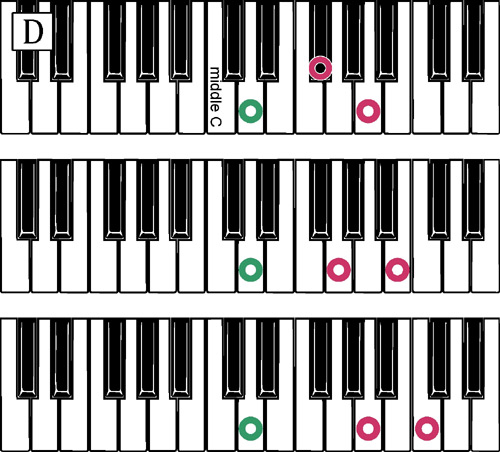
The written-out music for the pattern in D looks like this:

Remembering the keys
Note that the pattern in G uses only white keys:

The patterns in C and D each use one black key. The black key in the C pattern is the highest of the five right hand keys:

The black key in the D pattern is the lowest of the five right hand keys:

Module Summary
Knowing which notes (piano keys) you use is obviously essential for playing any riff – and these three sets of Moving Pair Riff notes can potentially generate nearly all possible twelve-bar music (in key G!).
Take the time to learn them thoroughly now and avoid frustration later on.
Here's the 'walk-through' video - but work through the study notes for that dual-coding learning boost.
There’s a side-track study called 'Dominant Doodle' which drills these three sets of notes in a less beat-intense way, if you prefer – and is a nice performance piece, too.
|
OUT NOW! |
THE MUSICARTA BEAT & RHYTHM WORKBOOK At last! An effective approach to keyboard rhythm & syncopation skills. Learn more! |
ONLY $24.95! |
TWELVE-BAR |
The MusicartaA methodical approach to keyboard syncopation for
|
PUBLICATIONS
exciting keyboard
creativity courses
CHORDS 101
WORKBOOK

~HANON~
video course

Musicarta
Patreon
PENTATONICS
WORKBOOK
video course

Creative Keyboard
video course

BEAT AND RHYTHM
WORKBOOK

- Volume 1 -

12-BAR PIANO
STYLES WORKBOOK

MUSICARTA MODES
WORKBOOK

PIANO STYLE

CANON PROJECT
video course

VARIATIONS
video course


- Piano Solo -
video course

- Piano Solo -


YouTube playlists





 THE LOGO
THE LOGO
